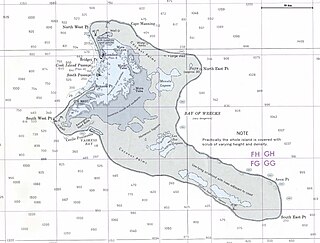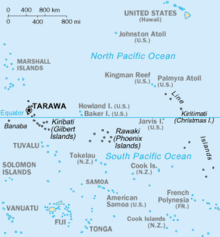
Kiribati, officially the Republic of Kiribati, is an island country in Oceania in the Central Pacific Ocean. Its permanent population is over 119,000 (2020), with more than half of whom live on Tarawa atoll. The state comprises 32 atolls and one remote raised coral island, Banaba. Its total land area is 811 km2 (313 sq mi) dispersed over 3,441,810 km2 (1,328,890 sq mi) of ocean.

The islands which now form the Republic of Kiribati have been inhabited for at least seven hundred years, and possibly much longer. The initial Austronesian peoples’ population, which remains the overwhelming majority today, was visited by Polynesian and Melanesian invaders before the first European sailors visited the islands in the 17th century. For much of the subsequent period, the main island chain, the Gilbert Islands, was ruled as part of the British Empire. The country gained its independence in 1979 and has since been known as Kiribati.

The Gilbert Islands are a chain of sixteen atolls and coral islands in the Pacific Ocean, about halfway between Papua New Guinea and Hawaii. They constitute the main part of the nation of Kiribati.

The Gilbert and Ellice Islands in the Pacific Ocean were part of the British Empire from 1892 to 1976. They were a protectorate from 1892 to 12 January 1916, and then a colony until 1 January 1976. The history of the colony was mainly characterized by phosphate mining on Ocean Island. In October 1975, these islands were divided by force of law into two separate colonies, and they became independent nations shortly thereafter: the Ellice Islands became Tuvalu in 1978, and the Gilbert Islands became part of Kiribati in 1979.

Gilbertese or taetae ni Kiribati, also Kiribati, is an Austronesian language spoken mainly in Kiribati. It belongs to the Micronesian branch of the Oceanic languages.

Ieremia Tienang Tabai is an I-Kiribati politician who served as the first Beretitenti President of the Republic of Kiribati, after being the youngest ever Chief minister of the Commonwealth of Nations and then becoming the youngest ever head of State. During his presidency, he was described as being the most able leader of the Pacific island states.

Pillars of Truth was a political party in Kiribati, until 2020 when it merged with the Kiribati First Party to create the Boutokaan Kiribati Moa Party.

Nikunau is a low coral atoll in the Gilbert Islands that forms a council district of the Republic of Kiribati. It consists of two parts, with the larger in the northwest, joined by an isthmus about 150 metres (490 ft) wide.

Nonouti is an atoll and district of Kiribati. The atoll is located in the Southern Gilbert Islands, 38 km north of Tabiteuea, and 250 km south of Tarawa. The atoll is the third largest in the Gilbert Islands and is the island where the Roman Catholic religion was first established in Kiribati, in 1888.

London is a settlement in Kiribati, located on the island of Kiritimati, within the archipelago of Line Islands. In 2015, it was inhabited by 1,899 people, making it the second most populated of the four settlements of the island.

The Cabinet of Kiribati is the cabinet of the government of the Republic of Kiribati.
Japanese presence in Kiribati dates back to the end of 19th and the beginning of the 20th century, when labourers were hired to work in Kiribati's phosphate mines. The migration of some workers and labourers from Okinawa was seen as early as 1860 and the Meiji era. As compared to the other Micronesian countries which came under Japanese rule in the first half of the 20th century, the majority of the Japanese consisted of transient workers and only a few settled in Kiribati. Since Kiribati became independent in 1978, a few Japanese have also taken permanent residence in Kiribati, and assumed important positions within Gilbertese society.

Parliamentary elections were held in the Gilbert Islands on 1 February 1978, with a second round on 6 February.

Early parliamentary elections were held in Kiribati on 12 January 1983, with a second round on 19 January. All candidates for the 36 seats ran as independents. Voter turnout was 79.9%.

The Ministry of Education (MoE) is a government ministry of Kiribati, headquartered in Bikenibeu, Tarawa, next to the King George V and Elaine Bernacchi School. As of 2018 the ministry has about 1,400 employees.
Ratimiti Babera Kirata (1938-1991) was an I-Kiribati politician, elected in the House of Representatives in 1967 for the constituency of Onotoa. He was nominated candidate to the 1978 Gilbertese Chief Minister election. He was born in Onotoa where he was continuously elected MP from 1978 to his death, dying less than one month before the general election of May 1991. He was at that moment one of the possible candidates to the succession of Ieremia Tabai as the Beretitenti. He was one of the founders and the first president of the Gilbertese National Party and later of the National Progressive Party (Kiribati). He had been continuously member of the Cabinet of Kiribati from 1979 to 1991.

The Ministry of Finance and Economic Development is a government ministry of Kiribati, headquartered in South Tarawa.

The Ministry of Environment, Lands and Agricultural Development is a government ministry of Kiribati, headquartered in Bikenibeu, South Tarawa.

Roniti Teiwaki is an I-Kiribati politician.

The Kiribati Grand Order is the highest honour of Kiribati. The order was founded in 1989 under President Ieremia Tabai by the Presidential Act of 1 June 1989 which established the Kiribati honours system.












